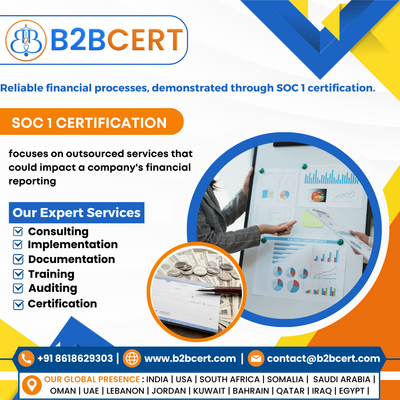Categories
Tags
Archives
SOC 1 Certification in the USA: What It Is and Why Your Busines
-
Posted by b2b cert23 Filed in Business #SOC 1 Audit in USA #SOC 1 Certification Services in USA 88 views
In an increasingly interconnected business world, trust and transparency are critical. If your company provides services that impact the financial reporting of your clients—such as payroll processing, data hosting, or accounting software—then demonstrating that you have effective internal controls is essential. That’s where SOC 1 Consultants in USA comes into play. SOC 1 (System and Organization Controls 1) is a type of third-party audit report that is especially relevant for service organizations in the United States. It assures your clients and stakeholders that your internal controls over financial reporting are well-designed and functioning effectively. In this blog, we’ll explore what SOC 1 certification means, how it works, and why it’s increasingly important for U.S.-based businesses.
What is SOC 1?
SOC 1 is a type of audit performed in accordance with Statement on Standards for Attestation Engagements (SSAE) 18, issued by the American Institute of Certified Public Accountants (AICPA). The purpose of a SOC 1 report is to evaluate the internal controls at a service organization that are relevant to its client’s financial reporting. For example, if your company processes transactions or handles sensitive financial data on behalf of clients, your operations could directly affect their financial statements. A SOC 1 report provides assurance to those clients—and their auditors—that your controls are appropriately designed and operating effectively.
SOC 1 Type I vs. Type II
There are two types of SOC 1 reports:
-
Type I: Assesses the design of controls at a specific point in time. It answers the question, “Are the controls suitably designed as of this date?”
-
Type II: Assesses both the design and operating effectiveness of controls over a period of time, usually 6–12 months. It answers the question, “Were the controls not only designed properly but also working as intended over time?”
Type II is generally more valuable in the eyes of clients and auditors because it provides a more comprehensive assessment of your internal control environment.
Why SOC 1 Certification Matters in the USA
Although SOC 1 in USA is not a legal requirement, it has become a standard expectation for service providers in finance, HR, cloud computing, and other industries handling sensitive or financially impactful data.
Here’s why SOC 1 certification is so important for U.S.-based companies:
1. Client Assurance
Your clients’ financial auditors will often request a SOC 1 report. Providing this can speed up audits and strengthen your client relationships.
2. Competitive Advantage
SOC 1 certification can differentiate your business from competitors who lack independent validation of their internal controls.
3. Risk Management
Going through the SOC 1 process often reveals weaknesses in control processes that you can improve, reducing operational and compliance risks.
4. Trust and Transparency
An independent SOC 1 audit shows that you take internal controls seriously—important for enterprise clients, investors, and regulators.
Who Needs SOC 1 Certification?
SOC 1 certification is most relevant for service organizations whose operations affect the financial reporting of their clients. Examples include:
-
Payroll processors
-
Third-party administrators (TPAs)
-
Claims processing companies
-
Data center and cloud hosting providers
-
Loan servicing companies
-
SaaS providers in the finance and HR space
-
Financial reporting software vendors
If your services are integral to your client’s internal controls over financial reporting (ICFR), a SOC 1 report is often required—either by the client or their external auditor.
The SOC 1 Certification Process
Achieving SOC 1 Registration in USA involves working with a licensed CPA firm that specializes in attestation audits. Here's a general breakdown of the process:
1. Scoping
Define the services to be audited, the period of review (for Type II), and the relevant control objectives.
2. Readiness Assessment
Before the formal audit, many companies undergo a readiness assessment to identify control gaps and remediation needs.
3. Remediation
Based on the assessment, update or implement controls and documentation to meet audit standards.
4. Audit Fieldwork
The CPA firm tests the design (Type I) and/or operational effectiveness (Type II) of your controls through interviews, documentation review, and system testing.
5. Report Delivery
If your controls meet the criteria, the CPA firm issues a SOC 1 report, which can be shared with current or prospective clients.
Key Components of a SOC 1 Report
A SOC 1 report typically includes:
-
A description of the service organization’s system
-
Control objectives and related controls
-
Auditor’s opinion on the design and/or effectiveness of the controls
-
Management’s assertion
-
Results of control testing (for Type II)
SOC 1 vs. SOC 2: What’s the Difference?
A common question is: What’s the difference between SOC 1 and SOC 2?
-
SOC 1 focuses on internal controls over financial reporting.
-
SOC 2 focuses on security, availability, confidentiality, processing integrity, and privacy—often more relevant for IT and SaaS companies that don’t directly impact financial reporting.
Some organizations pursue both, depending on client needs.
Final Thoughts
In today’s environment of increasing regulatory scrutiny and client expectations, SOC 1 Consultants Services in USA has become a critical trust signal for service providers. It offers transparency, mitigates risk, and helps businesses win and retain clients—especially in highly regulated or financial sectors. Whether you're scaling your operations or supporting publicly traded companies, investing in a SOC 1 audit can pay dividends in credibility and long-term success. It’s not just about compliance—it’s about building trust through proven reliability.
-





